8 warm salad recipes under 500 calories
Warm up your salad with hearty fall and winter fruits and vegetables.
Updated on October 23, 2023
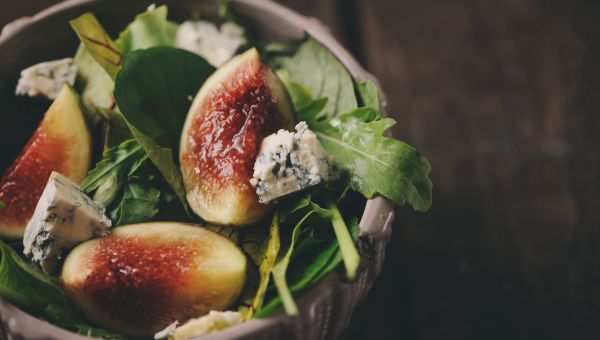
A big salad is a great way to get your daily dose of veggies and the nutrients your body needs. Plus, it makes summertime meal prep a breeze. But salads don’t have to be a one-season meal. Enjoy the flavors of dark greens and in-season veggies, even after the autumn chill sets in.
Fall fruits and veggies, like beets, Brussels sprouts, apples, and pears make tasty additions to your salad. And they’re even better served warm. “Grilling is great for fall fruits and veggies,” says Tammy Baranowski, RDN, a registered dietitian in Orange Park, Florida. “You can broil them, roast them, and if you're in a time pinch, you can just sauté them on top of the stove.”
Check out some of the tastiest fall fruits and veggies to add to your warm salad recipes.
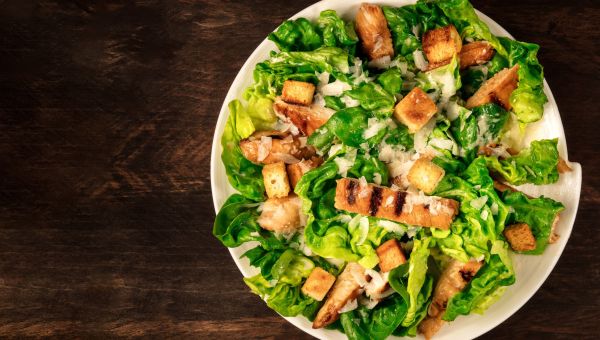
Healthy grilled Caesar
This non-traditional recipe is a salad lover’s dream.
First, slice hearts of romaine in half lengthwise, brush with a light layer of heart-healthy olive oil and toss on the grill. It sounds weird, but it tastes delicious!
Top your grilled romaine with a three-ounce serving of grilled chicken breast and a drizzle of homemade Caesar dressing. To whip up your own dressing, combine a tablespoon of plain non-fat Greek yogurt, a sprinkle of grated parmesan cheese, a squeeze of lemon juice, a dollop of Dijon mustard and garlic, and salt and pepper to taste.
This salad tastes indulgent but packs only 300 calories per serving.
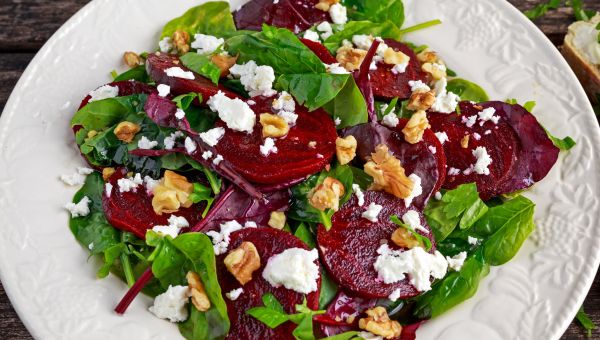
Roasted beet and arugula
This recipe comes with a nutritionist’s seal of approval. “I mix one cup of a spicy green, like arugula, with one cup spring mix, and top it with two roasted beets, one quarter of a cubed avocado, one ounce goat cheese, one tablespoon walnuts, and one tablespoon unsweetened dried cranberries,” says Baranowski.
This salad is packed with vitamins, minerals, heart-healthy fats, and flavor. The greens are loaded with vitamin A, which helps promote a healthy immune system and beets, a superfood boasting manganese, which is beneficial for bone health and metabolism.
Avocado, olive oil, and walnuts contain unsaturated fats that help lower levels of LDL (aka "bad" cholesterol). High cholesterol can increase your risk for heart disease.
Finish off your toasty salad with a homemade dressing. “I typically make my own vinaigrette, with olive oil, vinegar or lemon juice, and a touch of honey,” Baranowski says.
Dig into this dish for just 405 calories.
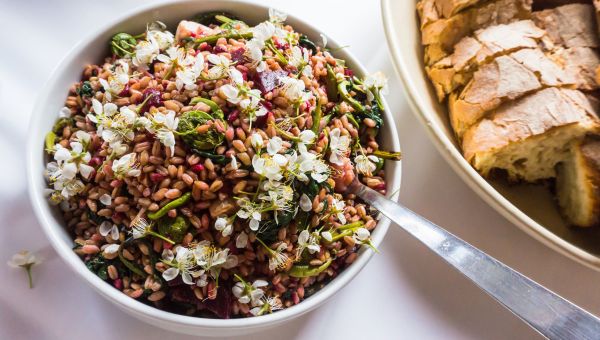
Warm farro with feta
Don’t limit your salads to just fruits and veggies—whole grains add loads of fiber and flavor, too.
The fall weather also produces a bounty of leafy greens. “There's such a variety of greens that are at their best in the fall, like Swiss chard, Belgium endive, and radicchio,” says Baranowski.
To assumeble this salad, boil a quarter cup of farro, following the directions on the package. Next, wilt a heaping handful of your favorite and fold it into your farro.
Top the mixture with a cup of oven-roasted broccoli or any of your favorite cruciferous vegetables, like cauliflower or Brussels sprouts, and a tablespoon of feta cheese. Farro contains seven grams of protein, and broccoli contains another three. If you’re looking to maximize your protein intake, add a grilled salmon filet, which contains 17 grams in every three ounces.
With a salmon filet, this salad contains 460 calories.
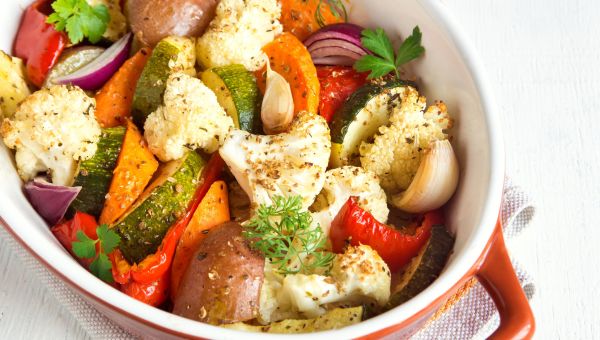
Toasted veggie medley
This veggie-rich dish is the perfect weeknight meal to whip up when you’re short on time. Chop up the seasonal veggies you have stocked in your fridge, like cauliflower, sweet potatoes, carrots, and bell peppers, and roast, grill or sauté.
The best thing about the fall veggies? “Roasting and serving them warm really brings out the flavors,” says Baranowski. Add some extra zest by sprinkling your favorite spices before roasting. “Fall veggies pair well with spices like curry, cinnamon and sage.”
Lightly drizzle chopped veggies with olive oil and spices. Then, toss about two cups of your roasted vegetables on a bed of chopped kale. Two cups of kale contain 70 calories, some heart-healthy omega-3 fatty acids, and loads of vitamins K and A. These vitamins are important for the production of healthy white blood cells and building strong bones, and omega-3s can help lower your risk for heart disease.
In no time at all, enjoy a warm, hearty salad that contains just 330 calories. Toss in a quarter cup of roasted chickpeas for 67 calories and about 4 grams of protein.
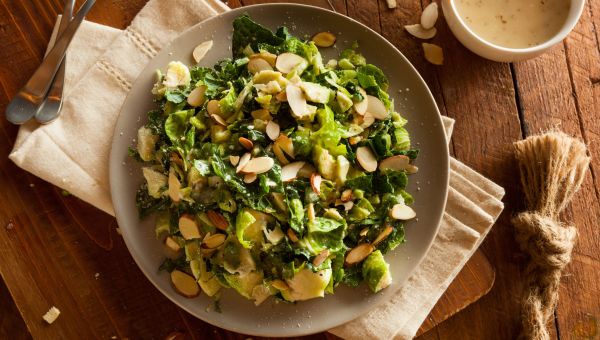
Warm Brussels sprouts and pears
Brussels sprouts are nutrient powerhouses. They’re loaded with vitamin K and folate, essential to proper blood clotting and DNA formation. They’re also packed with flavor, and taste incredible with sweet, juicy pears. Ditch the leafy greens for this recipe—these ingredients taste better alone.
Slice two cups of Brussels sprouts, drizzle with olive oil, and pop them into the oven and roast until the edges are crisp and golden brown. Prep your pear while your sprouts cook. “Grilling fall fruits like apples and pears is great,” says Baranowski. “Slice them thinly, add a light coating of oil so they don't stick, and grill them,” she recommends.
This salad wouldn’t be complete without a tangy dressing. Blend a tablespoon of olive oil, a teaspoon of apple cider vinegar, a squeeze of lime juice, a bit of honey, and your favorite spices.
Load your plate and enjoy for only 390 calories.
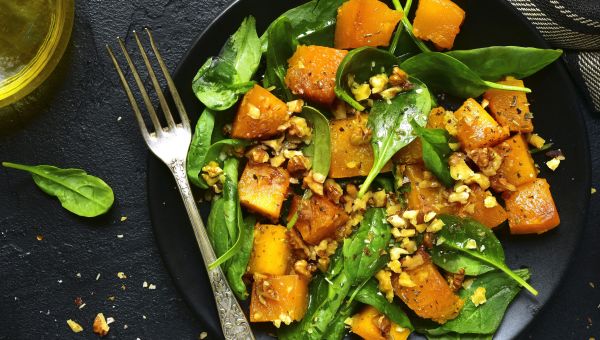
Savory sweet potato and turkey bacon
Top a bed of spinach with turkey bacon, sweet potatoes, and cinnamon.
To start, chop one medium sweet potato into bite-sized pieces, spread them on a baking sheet, and coat with a drizzle of olive oil and a dash of cinnamon.
While your sweet potato is roasting, prep the rest of your meal. In a sauté pan, crisp up two pieces of lean turkey bacon. Then, top two cups of fresh baby spinach with the sweet potato pieces and crumbled turkey bacon.
Looking to add more flavor? Sprinkle on the zest of an orange, then throw in some pumpkin seeds or a tablespoon of chopped nuts. “Nuts and seeds like pecans, pepitas—a type of pumpkin seed—or walnuts are the best nutritional bang for your buck,” Baranowski says.
A tablespoon of pumpkin seeds contains fewer than 60 calories, bringing the grand total of the meal to 345 calories.
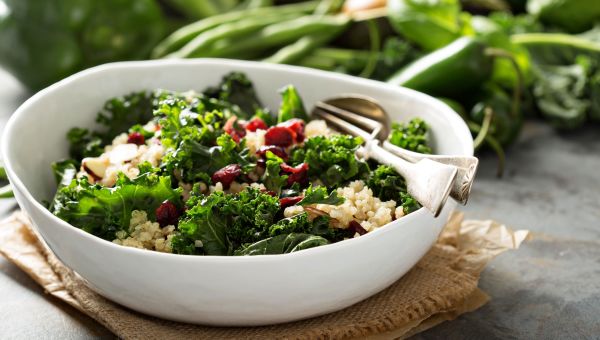
Wilted kale, apple, and quinoa
This salad pairs crunchy bites of apple with a warm, hearty grains. First, boil a quarter cup of dry quinoa in water or, for more flavor, low-sodium vegetable broth.
Next, add a tablespoon of olive oil, chopped garlic, and two heaping cups of chopped kale to a sauté pan. Cook the kale, stirring occasionally, until your greens are tender. Mix the wilted kale with the warm quinoa and top with cubes of Macintosh apple.
This recipe is packed with vitamins from the kale, a helping of fiber from the quinoa, and loads of flavor from this recipe’s most potent ingredient—garlic.
Up the flavor and protein with a few grilled shrimp. This tasty salad will fill you up without weighing you down at 480 calories.
If you're concerned about getting enough nutrients and keeping an eye on your calories, get into the practice of tracking your meals. Apps like Sharecare, for iOS and Android, make it easy to log the size and quantity of your meals.
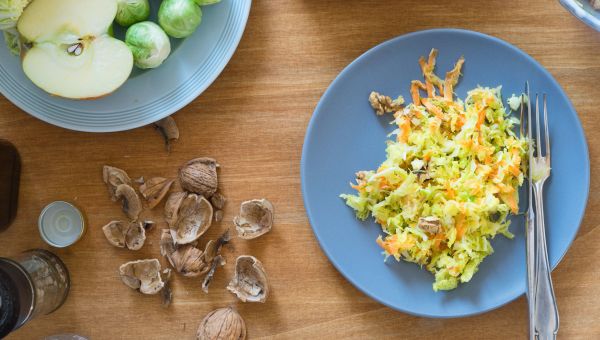
Warm Brussels sprout slaw
You'll never guess which little green veggies are loaded with vitamins C and K and contain about 55 calories per cooked cup. Brussels sprouts!
Whip up this belly-warming meal by spreading a cup of halved sprouts on a sheet pan with a teaspoon of olive oil, salt, pepper, and garlic powder and baking for 20 minutes at 350 degrees Fahrenheit. In the meantime, load your plate with a cup of washed baby arugula leaves, a quarter cup of thin apple slices, and a tablespoon of chopped walnuts. Drizzle with a combination of Dijon mustard and apple cider vinegar—about a tablespoon of each.
Remove your warm sprouts from the oven, slice into thin shreds, and sprinkle on your salad. The whole dish contains about 200 filling calories.
More On


video

article
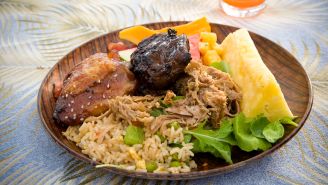
slideshow


video


video
